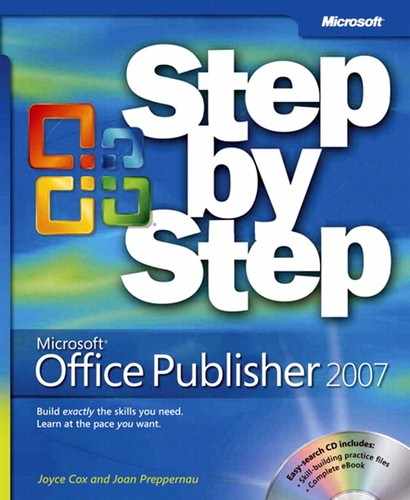When you create a new publication, it exists only in your computer’s temporary memory until you save it. Even if you will never use a particular publication again, you might want to save it so that you can use it later as the basis for a similar publication.
The first time you save a publication, you can click the Save button on the Standard toolbar or click Save or Save As on the File menu. Either action opens the Save As dialog box, where you can assign a name and choose a storage location.
In Publisher, the dialog boxes that allow you to navigate to a particular storage location, such as the Save As and Open dialog boxes, are linked. If this is the first time in this Publisher session that you have used one of these dialog boxes, it displays the contents of your Documents folder. Subsequently, it displays the contents of whatever folder you last used. You use standard Windows techniques to navigate to or create other folders.
See Also
For information about navigating in Windows Vista, refer to Windows Vista Step by Step by Joan Preppernau and Joyce Cox (Microsoft Press, 2007).
After you save a publication for the first time, you can save changes simply by clicking the Save button on the Standard toolbar. The new version of the publication then overwrites the previous version.
Tip
By default, Publisher saves the publication you are working on every 10 minutes, in case the program stops responding or your computer shuts down unexpectedly. To adjust the time interval between saves, click Options on the Tools menu in an open publication, click the Save tab, and change the Save AutoRecover setting to the interval you want.
If you want to keep both a new version of a publication and the original version, click Save As on the File menu and save a new version with a different name in the same location or with the same name in a different location. (You cannot have two files with the same name in the same folder.) When you save a new version of a publication in this way, the new version is active in Publisher, and the original version is not.
If you want to be sure you can return to a previous version of a publication if you don’t like the results of changes you make, you can save a backup of the publication. Instead of clicking Save in the Save As dialog box, click the Save arrow and then click Save With Backup. Publisher saves a separate copy of the publication in the same folder.
If more than one publication is open, you can close the active publication by clicking the Close button at the right end of the title bar. If only one publication is open, clicking the Close button closes the publication and also quits Publisher. If you want to close the publication but leave Publisher open, you must click Close on the File menu. Publisher then displays the Getting Started window so that you can choose another publication to work on.
Tip
If you have several publications open and you want to quit Publisher, you don’t have to close the publications first. You can simply click Exit on the File menu.
In this exercise, you will save a new publication in a new folder. Then you will save the same publication with the same name in a different folder.
Display the two-page publication based on the Importing document.
On the Standard toolbar, click the Save button.
The Save As dialog box opens. In the File Name box, Word suggests a possible name for this file.
If your Save As dialog box does not display the Navigation Pane, click the Browse Folders button.
You can now easily navigate to different locations, change the folder view, and create new folders.
If the contents of your GettingStarted folder are not displayed, click Documents in the Favorite Links list. Then in your Documents folder, navigate to the Microsoft PressSBS_Publisher2007GettingStarted folder.
Replace the suggested name in the File name box with SeriesProposal, and then click Save.
Troubleshooting
Programs that run on the Windows operating systems use file name extensions to identify different types of files. For example, the extension .pub identifies Publisher documents. Windows Vista programs do not display these extensions by default, and you shouldn’t type them in the Save As dialog box. When you save a file, Publisher automatically adds the extension associated with the file type selected in the Save As Type box.
Notice that SeriesProposal now appears in the publication title bar. From now on, you can click the Save button any time you want to quickly save changes to this file. Publisher already knows the name of this file, so instead of asking you to name the file, it simply overwrites the previous version with the new version.
On the File menu, click Save As, and then on the dialog box’s toolbar, click the New Folder button.
Type My Publications as the name of the new folder, and then press
 .
.My Publications is now the current folder in the Save As dialog box.
Click Save.
The Save As dialog box closes, and Publisher saves the SeriesProposal file in the My Publications folder. You now have two versions of the document saved with the same name but in different folders.
On the menu bar, click the Window menu.
At the bottom of the menu is a list of the currently open publications.
Click Publication1 in the list to display the one-page publication you created earlier in this chapter.
Click the Close button at the right end of the Publisher program window title bar to close the publication without saving it.
On the File menu, click Close to close the SeriesProposal publication without quitting Publisher.


